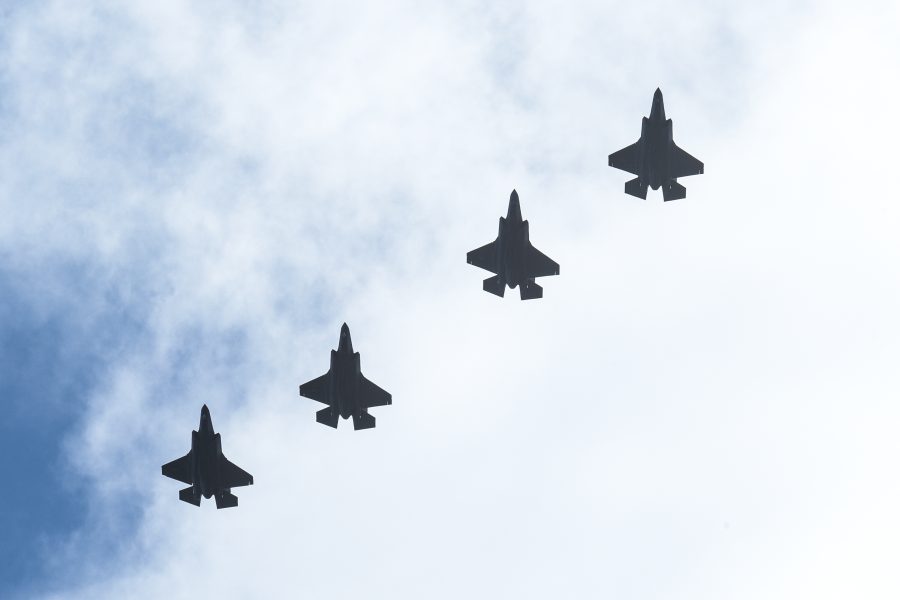The Air Force would only bed down 25 F-35s in fiscal 2026 under a plan included in a recent Pentagon report on the fighter. The plan calls for the service to field some 700 of the jets by the end of the decade and never buy more than 48 in any given year.
The Selected Acquisition Report, which was completed Dec. 31, 2023, but only cleared for public release on Aug. 7, 2024, includes an “Operational Fielding Plan” for all three variants of the F-35. The Air Force’s fielding plan and inventory shows that 419 Lightning IIs were in the service’s inventory at the end of 2023, but more will be added annually in an irregular pattern. The service also expects losses of between two and four F-35s per year.
F-35A Fielding Plan and Inventory
| Year | Fielded | Losses | Decommissioned | Inventory |
|---|---|---|---|---|
| 2023 | 0 | 0 | – | 419 |
| 2024 | 51 | 3 | – | 467 |
| 2025 | 57 | 2 | – | 522 |
| 2026 | 25 | 3 | – | 544 |
| 2027 | 39 | 3 | – | 580 |
| 2028 | 44 | 3 | – | 621 |
| 2029 | 47 | 4 | – | 664 |
An Air Force official said the figures should not be construed as mirroring planned Air Force budget requests but reflect “a number of factors” affecting how fast jets can be purchased, delivered, and absorbed into existing F-35 units and fielded in new locations.
Those factors likely include:
- The Air Force’s request for just 42 F-35s in the fiscal 2025 budget
- The fact that jets with the Tech Refresh 3 upgrade were being produced but not delivered during much of 2024 pending completion of TR-3 testing
- Assumed reductions to the buy from Congress pending corrections to various programmatic deficiencies
- The service’s desire to defer larger purchases until the preferred Block 4 version of the jet is tested and available
- Lockheed Martin’s difficulties in achieving intended annual production rates.
The official also noted that the plan dates to late 2023 and that there have been adjustments to the program since then which were not captured in the report.
The expected annual attrition losses are about double those predicated by the Marine Corps and Navy for their F-35 fleets, which range from zero to two per year.
The report separately plots a notional buying plan for the F-35A. The Air Force’s plan calls for buying 42 per year in fiscal 2025 and 2026, 47 in both 2027 and 2028, and then a steady 48 per year until 2048, with the last 34 aircraft planned for 2049, for a total of 1,763.
Under early plans for the program, the Air Force envisioned buying between 81 and 110 F-35s per year, with the intent of concluding production in the 2030s.
The Air Force only requested 42 F-35As in its fiscal 2025 budget request, down from previous requests of 48 per year. Senior service officials have said those numbers reflected other priorities, such as the need to develop the Next-Generation Air Dominance fighter and the associated Collaborative Combat Aircraft, and to procure F-15EXs to backfill F-15Cs rapidly aging out of the inventory.
The Marine Corps buying plan calls for a low of 13 F-35s per year in 2025 and 2026, and a high of 25 in 2032, which is the end year for its planned F-35B procurement, totaling 353 aircraft.
The Navy will similarly vary its buy of carrier-capable F-35Cs from just 13 in fiscal 2025, ramping up to 24 in 2029, and then declining to 15 toward the latter years, ending with 340 F-35Cs by 2035, the planned last year of production for the Navy.
By the end of fiscal 2029, the Marine Corps expects to have 245 F-35Bs in service, while the Navy expects to have 219 F-35Cs; together totaling 464 aircraft, or about two-thirds of planned Navy/Marine Corps procurement of 693 F-35s.
Together with the Air Force, the U.S. services expect to field 1,128 F-35s by the end of fiscal 2029. The numbers do not include production or fielding for international partners or Foreign Military Sales customers.
The Air Force set its objective of 1,763 F-35s circa 2005 and has not adjusted that figure since, despite growing inventories of fourth- and fifth-generation fighters in China, the proliferation of more lethal air-to-air and surface-to-air missile threats worldwide, and the pursuit of more advanced fighters like the NGAD.
Service officials say they are cognizant that reducing the planned buy would instantly increase the unit cost of the F-35 on paper, as developmental and beddown costs would be amortized over a smaller number of aircraft produced. This increase in turn would potentially lead to a Nunn-McCurdy breach, and potentially persuade Capitol Hill not to continue the program.
